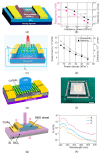Perovskite versus Standard Photodetectors
- PMID: 39203207
- PMCID: PMC11356170
- DOI: 10.3390/ma17164029
Perovskite versus Standard Photodetectors
Abstract
Perovskites have been largely implemented into optoelectronics as they provide several advantages such as long carrier diffusion length, high absorption coefficient, high carrier mobility, shallow defect levels and finally, high crystal quality. The brisk technological development of perovskite devices is connected to their relative simplicity, high-efficiency processing and low production cost. Significant improvement has been made in the detection performance and the photodetectors' design, especially operating in the visible (VIS) and near-infrared (NIR) regions. This paper attempts to determine the importance of those devices in the broad group of standard VIS and NIR detectors. The paper evaluates the most important parameters of perovskite detectors, including current responsivity (R), detectivity (D*) and response time (τ), compared to the standard photodiodes (PDs) available on the commercial market. The conclusions presented in this work are based on an analysis of the reported data in the vast pieces of literature. A large discrepancy is observed in the demonstrated R and D*, which may be due to two reasons: immature device technology and erroneous D* estimates. The published performance at room temperature is even higher than that reported for typical detectors. The utmost D* for perovskite detectors is three to four orders of magnitude higher than commercially available VIS PDs. Some papers report a D* close to the physical limit defined by signal fluctuations and background radiation. However, it is likely that this performance is overestimated. Finally, the paper concludes with an attempt to determine the progress of perovskite optoelectronic devices in the future.
Keywords: HOT devices; colloidal quantum dot (CQD) detectors; fundamental limits of photodetector performance (SFL and BLIP); perovskite photodetectors; photogating effect.
Conflict of interest statement
The authors declare no conflicts of interest.
Figures


















References
-
- Miyasaka T. Perovskite Photovoltaics and Optoelectronics. From Fundamentals to Advanced Applications. Wiley-VCH GmbH; Weinheim, Germany: 2022.
-
- Ding L. Perovskite Materials and Devices. Wiley-VCH GmbH; Weinheim, Germany: 2022.
-
- Sutherland B.R., Sargen E.H. Perovskite photonic sources. Nat. Photonics. 2016;10:295–302. doi: 10.1038/nphoton.2016.62. - DOI
-
- Jagielski J., Kumar S., Yu W.-Y., Shih C.-J. Layer-controlled two-dimensional perovskites: Synthesis and optoelectronics. J. Mater. Chem. C. 2017;5:5610–5627. doi: 10.1039/C7TC00538E. - DOI
-
- Goldschmidt V.M. Die Gesetze der Krystallochemie. Die Naturwissenschaften. 1926;14:477–485. doi: 10.1007/BF01507527. - DOI
Publication types
Grants and funding
LinkOut - more resources
Full Text Sources
Miscellaneous

